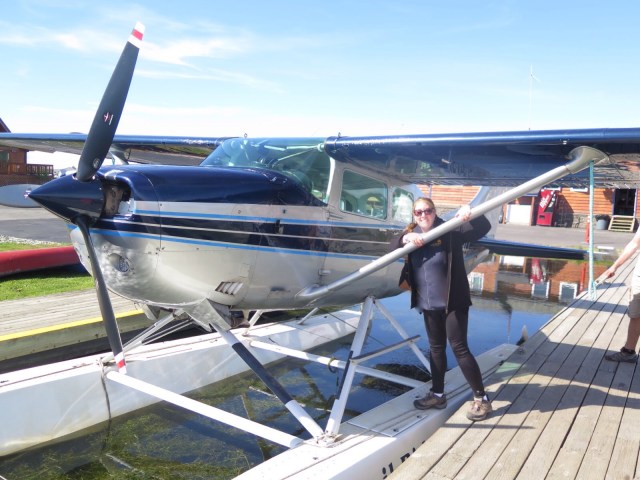You will see other photos of this raven flying over the Grand Canyon in the blog next week when I showcase the fauna of the national parks, but I felt this one perfectly projects the theme of this post.
Our grand finale was a small plane flight over the Grand Canyon. This plane was more commuter size rather than the four-seat float plane I rode in my flight from Homer to Anchorage, Alaska:
Grand Canyon Plane
Alaska Float Plane
Still it was another adventure as you never know when you are going to hit an air pocket, although as it turned out it was smooth sailing all the way. We did have to manage weight load as all our luggage was also on board – if you remember our Alaskan luggage got a separate trip in a van driven by one of our guides, J who met up with us back in Anchorage.
So all the luggage in the back, no passengers seated in the last few rows, we checked our flight plan and were ready to go. We actually flew in the reverse direction of the map’s plane, starting at the South Rim and landing in Boulder CIty.
Once up in the air, the flight was on even keel, so we were able to walk around the cabin to get the best views, even into the cockpit with the pilots (it was a private charter flight).
There was no crying this time, although the view was incredible, as we were looking at portions of the Grand Canyon not accessible on the ground.
We first traveled over a very arid portion of the Canyon:
Here and there, were pockets of vegetation:

A great cheer went up in the plane as we sighted the Colorado River:
We soon started to see signs of Lake Mead, which is the largest reservoir in the United States. About 24 miles southeast from the city of Las Vegas, Lake Mead sits along the border between Nevada and Arizona:
Lake Mead’s capacity is controlled and closely measured – if rainfall, runoff is not sufficient, additional waters are siphoned from nearby Lake Powell in an effort to sustain residents, farmers, tribes and businesses in this area. The high-water line is at 1,229 feet above sea level. Here is a map of Lake Mead. The blue tack represents Hoover Dam:
Unfortunately Lake Mead and Lake Powell are experiencing a dangerous drought with Lake Mead presently at only 37% of capacity. This is its lowest point since the Hoover Dam was completed in 1936. The last time it was at full capacity was in 1983. Evidence of this reduction in water level is seen in a “bathtub ring” effect of white mineral deposits. I witnessed a similar drought produced ring when I visited Lake Powell in 2003 during another severe drought. The level of the water should be near the reddish, brown portion of the walls, seen below:
Sadly, the present drought is not expected to end anytime soon.
We continued our journey and soon another image came into our view, but let’s go back in time for a minute. Human inhabitants in this desert area go back as far as 10,000 years and Native American tribes such as the Paiute made this their home in the 700’s AD. The area was christened “Las Vegas” – the meadows – by a Spanish trader in the early 1800’s.
After 1848 Las Vegas became part of the United States until 1855 when Mormon settlers were sent into the area; however they were unsuccessful and abandoned their efforts. In 1905, ranchers and railroads founded a city that was the beginning of a new Wild, Wild West with gambling and prostitution its main assets. Even though gambling was outlawed by Nevada in 1910, the practice continued illicitly until it was again legalized in 1931.
Lured by this, organized crime arrived in the 1940’s and built casinos to help launder monies gained from other illicit dealings such as drugs and racketeering and a section of the highway that housed many of these hotels/casinos was named “The Strip.”
Soon “respectable” investors from Wall Street, banking and even the Mormons once again flocked into the area. Bigger and bigger casinos were built, surviving a recession and today over 40 million people visit yearly.
This is Las Vegas today:
A rather bizarro way to end an adventure into the natural wild beauty of our national parks, don’t you think? Rather than mountains and geysers and canyons we now are faced with the Sports Book:

In good conscience I cannot end this journey here so next week as promised I will provide nature’s encore with a look at the magnificent creatures (other than human) we encountered across the parks.
#

























That was a pretty neat flight trip! We took the helicopter tour instead and it too was awesome!
Sometimes pictures don’t do it justice but yours always come very very very close! xx
Thanks Dom!